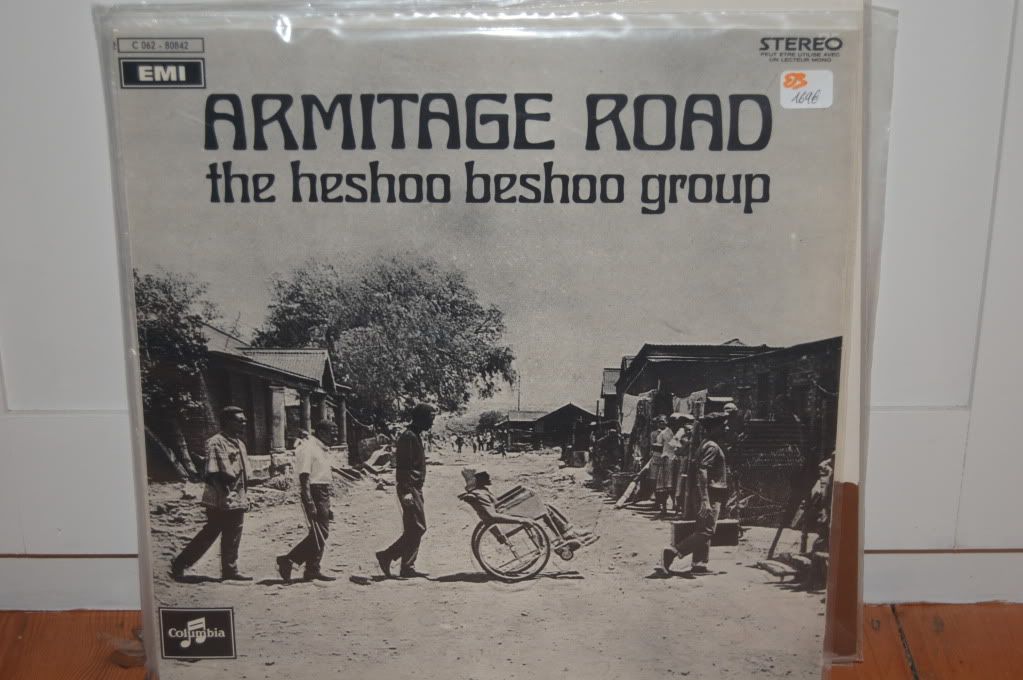The Heshoo Beshoo Group comprised Henry Sithole on alto sax, his brother Stanley Sithole in tenor, Cyril Magubane on guitar, Ernest Mothle on bass and Nelson Magwaza on drums. This is there only record together and it is marvellous. Like Batsumi (read about them here) The Heshoo Beshoo Group created a persuasive mix of American jazz and African jazz and create a sound of their own.
The music was composed by guitarist Cyril Magubane and, as you might expect, the guitar features prominently on every track. Magubane's playing owes a lot to US jazz guitarists such as Wes Montgomery and Kenny Burrell. However, it owes just as much to South African traditions of guitar playing.
The guitar features on many South African jazz records with amazing guitarists such as Phillip Tabane, Lucky Ranku, Allan Kwela and Ray Phiri of Stimela featuring prominently. Unlike US jazz, guitars are an integral part of jazz in South Africa rather than a slightly unusual instrument struggling against the horns.
Like jazz itself, the spread of the guitar throughout Africa, and in South Africa in particular, was a symptom of increased urbanisation. With increasing numbers of people migrating to urban areas, especially with the development of the gold mining industry, traditional music making, and traditional instruments were forced to adapt to new social conditions. Mineworkers who came from across southern Africa, brought their instruments with them but slowly replaced them with Western instruments. Instruments such as guitars, accordions and pennywhistles, while relatively cheap and easy to come by, also represented modernity, and a new urban condition and could even be seen as sign of success and prosperity.
It is probable that the guitar, like the accordion, was brought to Africa by European sailors and it seems to have arrived at about the same time in West Africa and South Africa. Like the pennywhistle, its popularity owed something to its similarity to already existing instruments, making its adoption somewhat easier. Styles of playing changed from one part of the continent to the other. However, the advent of recording, and of radio in particular, made it easier for styles of playing, as well as the songs themselves, to spread much further than ever before.
In South Africa the kwela boom also helped popularise the guitar. While not as cheap to buy as the pennywhistle many aspiring musicians made their own guitars. Apparently jazz superstar Sipho Gumede started his musical career on a home-made guitar.
However, the guitar might also represent a bridge between 'traditional'music and 'international' jazz. The adoption of the instrument by mineworkers, in particular Zulus, meant that, when they finished their work periods, they took their guitars back home with them. So popular was the instrument that it became an integral part of 'traditional' music making, while at the same time being an 'urban' instrument. In contrast, saxophones, pianos or trumpets were urban and owed much to European styles and methods of playing. I think that the popularity of the guitar in South African jazz was a factor behind the rise of Afro-Rock bands in Europe in the 70s. Without the guitar the bands would have seemed too 'jazz' for rock audiences, but their presence allowed bands such as Osibissa and Assagai to be considered 'rock'.
One of the things I like about Armitage Road is the way that the guitar is an equal partner to the horns. For me US jazz records with lead guitars are, like US jazz records with lead saxophonists, often about the 'star' with the other musicians backing him up. The Heshoo Beshoo Group are not like that at all. They feel more like a band in which they are all equals, and as such the music is much more integrated. Magubane provides rhythm as well as lead guitar giving each song amazing continuity. His playing is shown off to outstanding effect on Emakhaya, which starts with him playing unaccompanied before the rest of the band come in behind him. His solo on this track is a thing of funky beauty.
The Sithole brother's playing is also great. To me their style seems to owe a great deal to Winston Mankunku and therefore, I guess to John Coltrane. The brothers, together with Nelson Magwaza would go on to form The Drive, one of South Africa's most successful soul jazz groups.
Ernest Mothle eventually left South Africa, as did so many musicians, and played in Jabula with another great South African guitarist, Lucky Ranku, and Julian Bahula, as well as in Chris McGregor's Brotherhood of Breath.
There is a 'funky', danceable element to this record, and I invariably find that without knowing it I am tapping my feet and nodding my head. It combines graceful and moving playing with invention and passion. What more do you want?
The cover, as has been pointed out on flatinternational (here) references The Beatles' Abbey Road sleeve. The message is clearly that Armitage Road, in contrast to Abbey Road, is a place of poverty which has been caused by apartheid. The guy in the wheel chair is Magubane who suffered from polio.
My copy is a French copy on Pathe Marconi. I'm not sure how this record came to have a French pressing, international distribution being something that South African jazz records simply didn't have. If anyone knows let me know!

Did you know that you can shorten your urls with Shortest and receive cash from every visit to your shortened links.
ReplyDelete